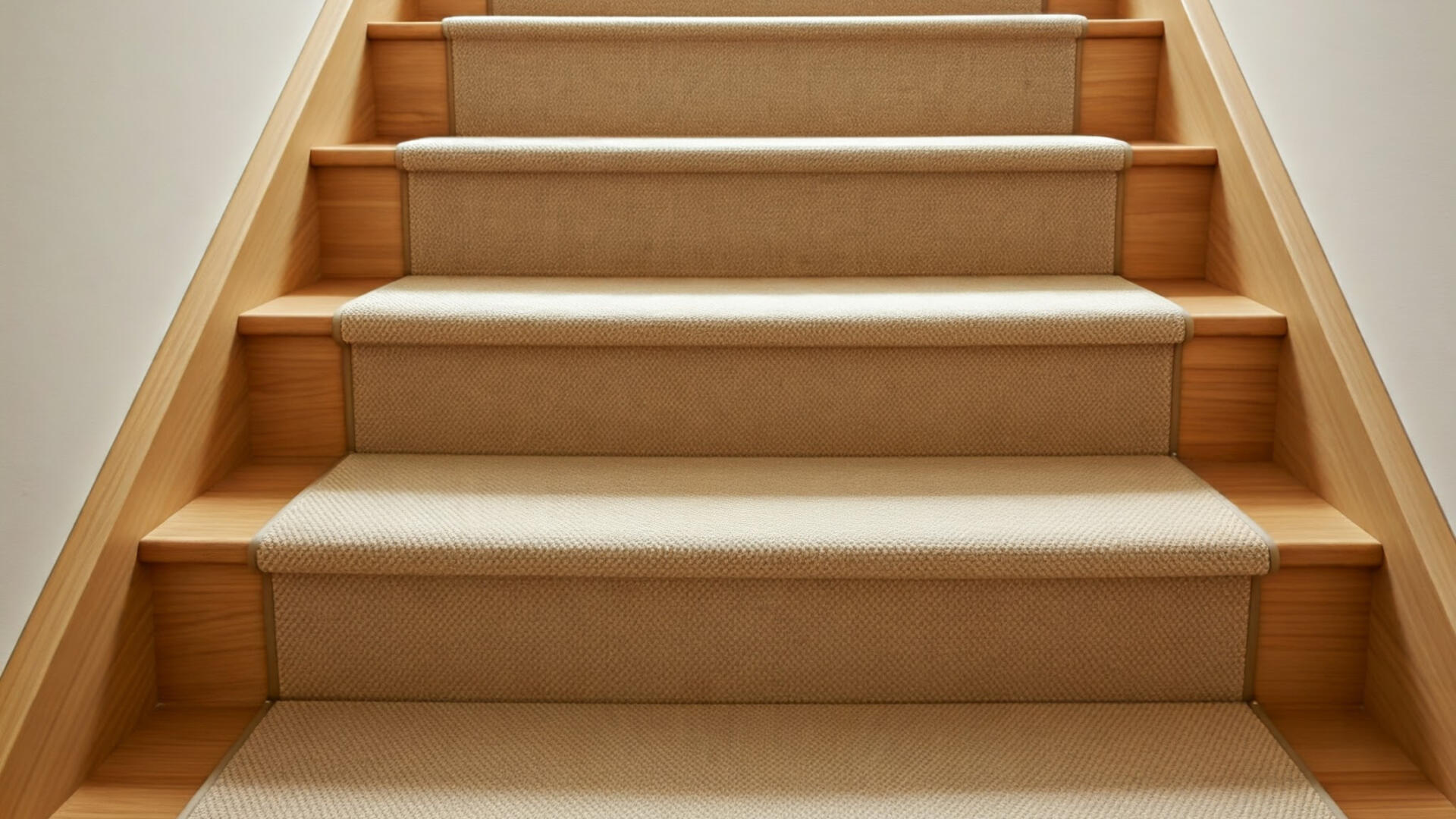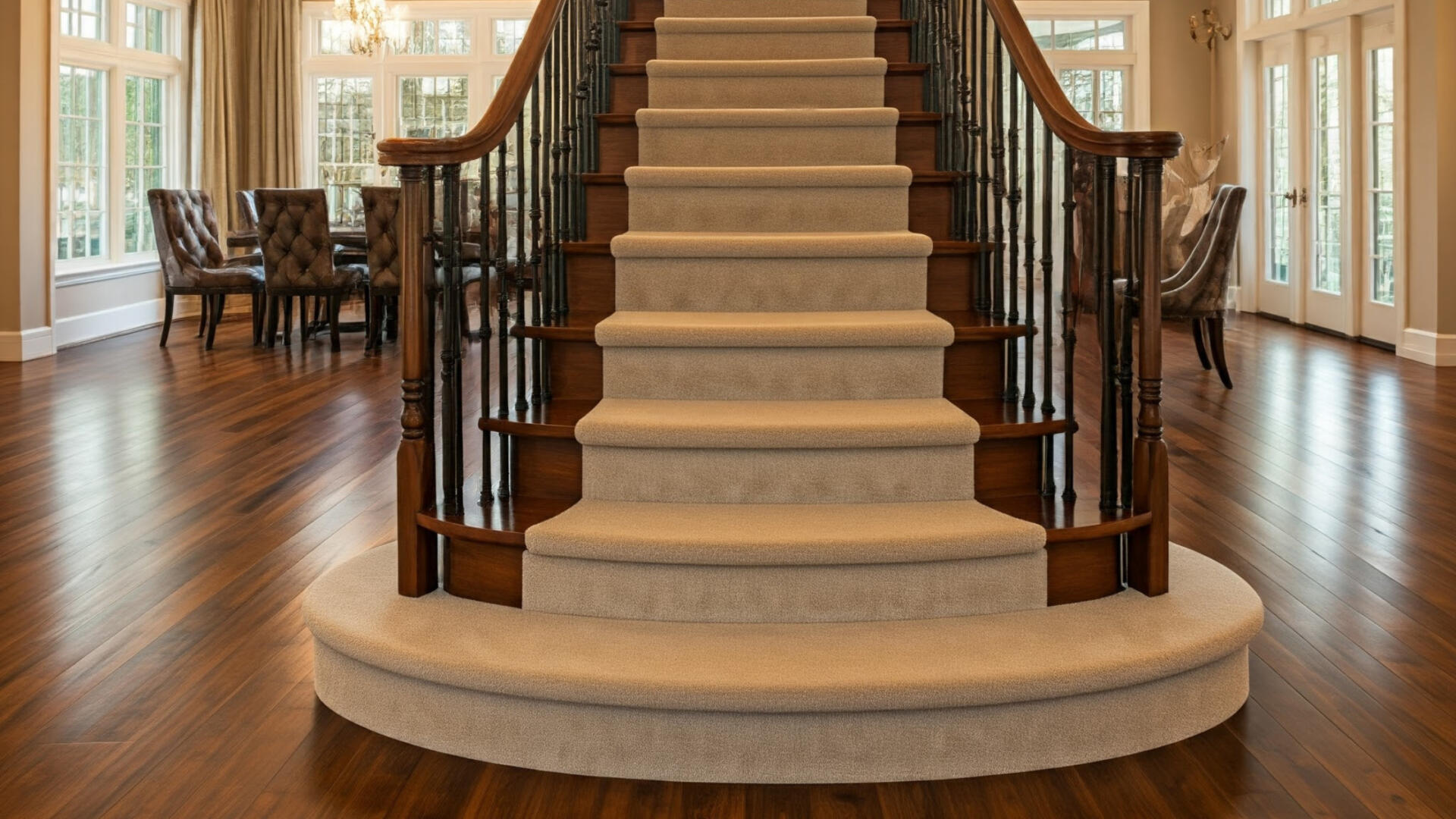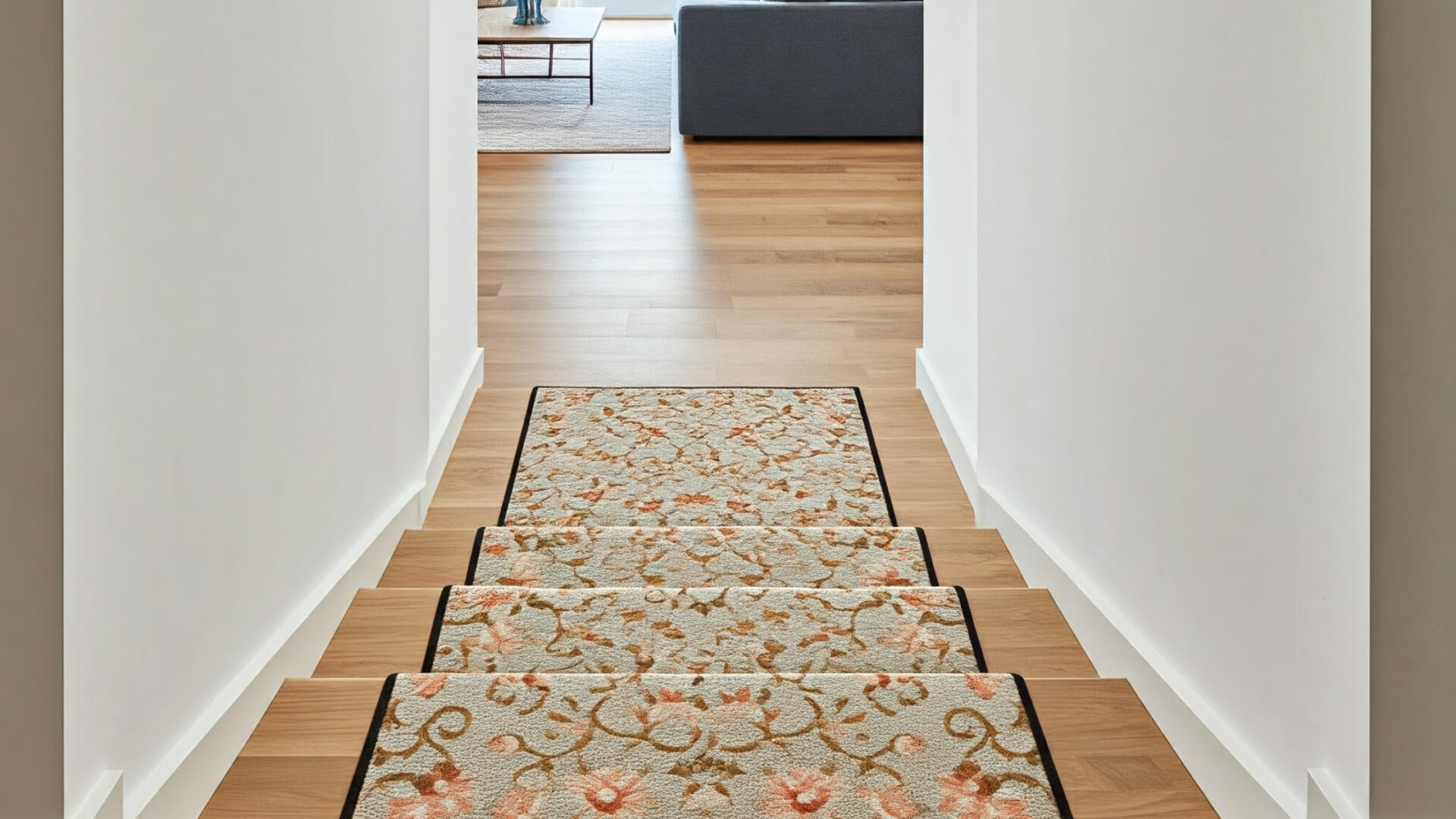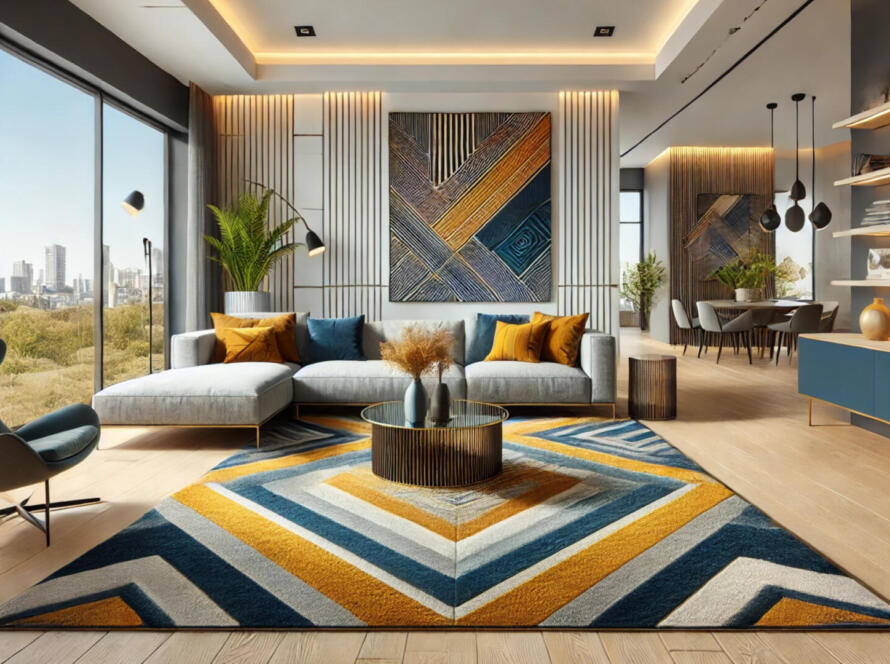When it comes to decorating your home, staircases are often overlooked. Many people focus on wall colour and texture, furniture and decor. Staircases are a central part of any multi-level home and can make a big impact on the overall look and feel of your space. Carpeting your stairs adds a decorative element along with safety and comfort. However, there are a few things to keep in mind when selecting the right carpet for your staircase.
Benefits of Carpeting Staircases
Hardwood or tiled stairs can be slippery, especially for children, pets or elderly family members. Carpets provide traction, reducing the risk of slips and falls and enhanced safety. Carpeting also helps in noise reduction. Stairs can be noisy as people go up and down. Carpet acts as a sound buffer, making your home quieter and more peaceful. A soft, cushioned carpet makes the journey up and down stairs more comfortable. A well-chosen carpet can make your staircase look elegant and tie the whole space together, adding colour, pattern, and texture.

Choosing the Right Carpet for Staircases
Choosing the Right Material
The material you select for staircase carpeting should balance durability, safety and style. Wool is one of the most durable and natural materials available. It has a luxurious feel, holds up well to high foot traffic and is naturally flame-retardant. Wool also offers good traction, making it a great choice for stairs.
Nylon is another excellent option for staircases because of its durability and affordability. It is strong and resilient, able to withstand wear and tear and provides good grip. While not as durable as wool or nylon, polyester is a more budget-friendly option. It is soft and stain-resistant, making it a good option for homes with kids or pets. Olefin is a durable synthetic fibre, commonly used for outdoor carpets. It is resistant to staining, fading and moisture, making it useful for areas with heavy foot traffic like staircases.
Look for carpets specifically designed with an anti-skid backing. This feature is crucial on stairs to prevent the carpet from moving around and creating a tripping hazard. Some carpets have rubber backings or additional padding that help keep the carpet in place.
Picking Patterns
The pattern of your staircase carpet can either enhance your space or overwhelm it. Consider subtle patterns for small spaces. If your staircase is in a tight or small area, opt for subtle patterns like small geometric shapes or light textures. This will make the space feel less cluttered and more spacious.
Use bold patterns for a statement. If your staircase is a prominent feature or in an open area, go bold with your pattern choice. Stripes, prints and intricate designs can add personality and make the staircase a focal point. Make sure the pattern you choose flows well from step to step. A continuous design helps create a cohesive look and minimises the risk of visual disruption when climbing the stairs.

Opt for Durability
Staircases experience a lot of foot traffic. You’ll want a carpet that is highly durable and doesn’t wear out too quickly. Consider carpets with a tight weave or a loop pile construction, as these tend to hold up better under heavy use. A carpet with a tight weave will last longer as it is less prone to wear and tear. Staircases are a high-traffic area, so durability is key. Carpets with a low pile height (short fibres) are more durable and less likely to flatten out over time. Low pile carpets are also easier to clean and maintain, which is important for staircases that gather dust and dirt.
Carpet Maintenance
Choose a carpet that is easy to clean. Stairs tend to get dirty quickly, especially if they’re near a front door or in a frequently used part of the house. Look for stain-resistant options. Some carpets come with built-in stain resistance or can be treated with stain protectors. This can help keep your staircase looking fresh and clean over time. Choose a carpet that is easy to vacuum. Stairs can be a bit challenging to clean, so a carpet that doesn’t trap too much dirt or debris will make maintenance easier.
What to Avoid When Carpeting Staircases
Avoid Thick and Plush
While thick, plush carpets may feel amazing in bedrooms or living rooms, they are not ideal for staircases. Thick pile carpets tend to wear out quickly on stairs and can cause tripping. They provide too much cushioning- overly cushioned or soft carpets lose their shape quickly, especially on stairs where the pressure from foot traffic is concentrated in one spot like the edge of each step. Plush carpets are also harder to wrap around the nosing, which can lead to an uneven and unprofessional appearance.

Avoid Slippery Materials
Some carpet materials, like silk or satin, may look luxurious but are slippery and unsuitable for staircases. The last thing you want is a slippery carpet that increases the risk of falls. Fibres like silk or even some types of polyester may not provide enough traction. Stick to wool, nylon or other materials known for their grip. Some carpets come with glossy or shiny finishes that can be slippery. These should be avoided for safety reasons.
Overly Intricate Patterns
While a bold pattern can make a statement, be careful with overly intricate designs. They can make the staircase look too busy and can even be disorienting when going up and down the steps. Extremely detailed or cluttered patterns may make it hard to distinguish the steps, increasing the likelihood of tripping. Opt for simple, well-spaced designs that are easy on the eyes.
Avoid Loose Rugs or Runners
Loose rugs or runners on stairs can be dangerous if not properly installed. They can shift around, creating a tripping hazard. Always ensure that your carpet or runner is securely fastened to the stairs with either carpet tacks or adhesive. If you’re using a runner, make sure it’s properly aligned and doesn’t move when stepped on.

Overlooking the Padding
Padding is often an afterthought, but it plays a crucial role in extending the life of your carpet and adding comfort. However, it’s important to choose the right type of padding for stairs. Avoid thick padding. Thick padding may feel nice, but it can make the carpet more likely to stretch and move. Opt for a thinner, dense padding that provides support without being too soft.
While it may be tempting to install carpet yourself, staircase carpeting is best left to professionals. Staircases are tricky to carpet because each step needs to be measured and fitted perfectly to avoid wrinkles or loose edges. A professional will ensure that the carpet is tightly secured and looks seamless.
Carpeting your staircase can elevate the look of your home while providing safety and comfort. By choosing the right materials, patterns and designs and avoiding slippery, overly plush, or intricate options, you can create a stylish and functional staircase. Remember, durability and safety should be your top priorities.
Frequently Asked Questions
What is the best material for staircase carpeting?
- The best materials for staircase carpeting are those that offer durability, safety and comfort. Wool and nylon are top choices because they are strong, long-lasting, and provide good traction to prevent slipping. Wool also has a luxurious feel and is naturally flame-retardant, while nylon is a more affordable option that resists wear and tear.
- Polyester and olefin are good budget options, but wool and nylon generally offer better durability for high-traffic areas like stairs.
Are thick or plush carpets a good option for stairs?
- No, thick or plush carpets are not recommended for staircases. While they may feel comfortable, they can lose their shape quickly due to concentrated foot traffic on the stair edges.
- Thick carpets can also be a tripping hazard and are harder to install around the nosing of each step, leading to an uneven appearance. It’s better to opt for low-pile, tightly woven carpets that provide both durability and safety.
How can I keep the carpet on my stairs from slipping?
- To prevent slipping, choose carpets with an anti-skid backing or ensure the carpet is securely installed. Some carpets come with rubber backings, and you can also use carpet tacks or adhesive to hold the carpet in place.
- If you’re using a runner, make sure it’s properly aligned and firmly secured to each step. Professional installation is highly recommended to ensure the carpet stays in place and provides the necessary safety.




